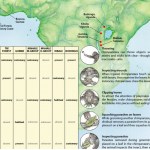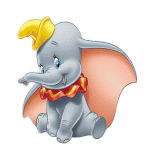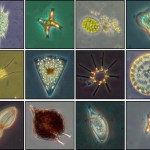mammals
What is culture? One simple definition might be: a distinctive behavior shared by two or more individuals, which persists over time, and that ignorant individuals acquire through socially-aided learning.
There are at least four different ways to learn a particular behavior or problem-solving strategy. That is to say, there are four different ways to learn. The first is social facilitation, in which one individual does the same thing as the demonstrator at the same time. Essentially this is a situation of on-line matching of motor actions. For example, I might learn the steps to a complicated…
In the Fayum desert of northern Egypt, not too far from the banks of the Nile, the vestiges of ancient forests are preserved in the sand-covered strata. The fossils are ghosts of a vanished oasis in which prehistoric cousins of modern elephants wallowed in lush wetlands and a host of ancient primates scrambled through the trees, and despite being known as one of the world's best fossil sites for over a century paleontologists are continuing to discovery new species from the desert rock. The trouble is that not all these new species are easily classified.
Approximately 37 million years ago,…
tags: Bait Ball Feast, natural history, animal behavior, plankton, herring, seabird, humpback whale, television, BBC, streaming video
In late summer, the plankton bloom is at its height. Vast shoals of herring gather to feed on it, diving birds round the fish up into a bait ball.
The skeleton of Megatherium, as figured in William Buckland's Geology and Mineralogy Considered With Reference to Natural Theology.
There is something fantastically weird about giant ground sloths. Creatures from a not-too-distant past, close enough in time that their hair and hide is sometimes found in circumstances of exceptional preservation, these creatures have no living equivalent. Their arboreal cousins still live in the tropics of the western hemisphere, but they can hardly be considered proxies for the ground sloths of the Pleistocene.
The most famous of these ancient beasts was…
...and what can word-learning in dogs teach us about the evolution of language in humans?
What is involved in the learning of a single new word? Consider the word "tiger", being learned by a child with already a modest vocabulary, at least for animal words. First the child must make a new entry in the mental lexicon - that "tiger" is a word in the first place. He has to categorize it as a noun. It has to be categorized under "animal" (a supernym) and related to its hyponyms, like "Sumatran tiger." Then, of course, the child has to learn what actual *thing* the word "tiger" refers to. Now,…
A close-up shot of a giant anteater (Myrmecophaga tridactyla), photographed at the National Zoo in Washington, DC.
[It's a really busy week over here at blog headquarters, because it is data collection week. Data collection week is awesome, but it means less time for blogging. So here's a piece from the archives. I picked this one especially for Drugmonkey, because he liked it so much.]
The Harpy Eagle (Harpia harpyja) is a nasty scary-looking muppethugging monster of a carnivorous bird. Female harpies weigh 14-20 pounds, and males weigh 8.5-12 pounds. They stand between 2.9 and 3.5 feet tall. The wingspan of the harpy eagle can reach 6 feet, 7 inches. The talons - sharp claws to grasp onto its prey -…
African wild dogs (Lycaon pictus), photographed at the Bronx Zoo.
African wild dogs (Lycaon pictus) don't have it easy. Their taste for large mammalian prey puts them in competition with lions and spotted hyenas for both prey and living space, meaning that wild dogs regularly have their kills stolen or are even killed by other predators. In fact, the dogs may even be unintentionally attracting the attention of these other hunters.
Like other social carnivores, African wild dogs communicate with each other through body language and olfactory cues, but they also employ a variety of high-…
Rokan the Sumatran tiger (Panthera tigris sumatrae), photographed at the National Zoo in Washington, DC.
Breaking down a hyena kill. Given competition with other carnivores, prehistoric hyenas (like their living counterparts) would probably have disarticulated and transported parts of horses they killed. From Diedrich 2010.
In Hollywood films, there is nothing like an assemblage of bones strewn about a cave floor to testify to the power and voraciousness of a predator. Every skeleton is a testament to the hunting prowess of the carnivore, which causes even more alarm when the person who has stumbled into the cave realizes that they have just walked into a literal dead-end.
Although amplified…
Let me tell you a little story. When I was born my parents had two cats. One was named Garfield. The other...well, I don't remember what the other one was called. Not long after I was born, and little Jason was coughing up furballs, the doctors informed the parents that their little bundle of skin and hair was allergic to cats. It was then that teams were picked and lines were drawn. It was me or the cats. Luckily, the parents decided to keep me, and lose the cats. Imagine how much it would have sucked if they decided to keep the cats and lose me. I imagine if my younger brother had actually…
The skull of a juvenile white-tailed deer (Odocoileus virginianus), photographed in suburban Pennsylvania.
I feel like I have been run over by a truck. Between blogging, working on my book, fieldwork, pitching freelance articles, and research, I just didn't have the energy to come up with something new today. Instead enjoy this post, written a little more than a year ago, about how the hip of a fossil whale was mistaken for the shoulders of an ancient bird. -- Brian
The right hip of Basilosaurus as seen in Lucas' 1900 description.
If you were a 19th century paleontologist and you wanted a skeleton of the fossil whale Basilosaurus, there was only one place to look; Alabama. Even though fossils…
A male pronghorn (Antilocapra americana), resting in the tall grass. Photographed on Antelope Island, Utah.
Utah may seem like an odd place to search for primates, but you can find them if you know where to look. Although scrubby and arid today, between 46-42 million years ago what is now the northeastern part of the state was a lush forest which was home to a variety of peculiar fossil primates. Called omomyids, these relatives of living tarsiers are primarily known from teeth and associated bits and pieces of bone, but newly discovered postcranial remains may provide paleontologists with a better idea of how some of these ancient primates moved.
For most of their early evolution omomyids were…
What information is contained in the call of a mammal? Some calls might reflect the internal emotional state of the animal, like fear or anxiety, or they can refer to an external object, agent, or event, like the presence of a predator. Rhesus monkeys, lemurs, baboons, and guinea pigs, for example, will produce calls when separated from their conspecifics or in the presence of a stranger. Howler monkeys produce specific alarm calls for avian predators, even when they have never encountered an avian predator for several generations. Vervet monkeys produce different calls in response to…
Today for Monday Pets, we're going to go old school and talk about vision.
Vision is arguably our most (intentionally) utilized sensory system, so its pretty important to figure out how it works. And it's what David Hubel and Torsten Wiesel set out to investigate starting in the late 1950s. Ultimately, their work would get them a Nobel Prize in Physiology or Medicine, in 1981.
Basically, they took a bunch of cats, anesthetized them, and showed them patterns of light on a screen. Meanwhile, some microelectrodes were placed in various precisely determined spots in the cat's visual cortex, and…




